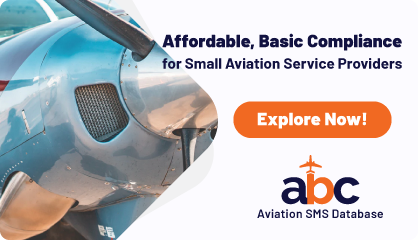
For new aviation safety managers, developing a safety management system (SMS) that meets Federal Aviation Administration (FAA) standards can be challenging, particularly when it comes to crafting effective risk controls.
Risk controls are the backbone of aviation safety risk management, designed to mitigate hazards and ensure safe operations. Poorly designed controls can lead to persistent risks, regulatory non-compliance, and safety incidents.
This evergreen guide outlines best practices for creating robust risk controls within an aviation SMS, helping safety managers build a compliant and proactive safety framework.
Why Effective Risk Controls Matter in Aviation SMS
Risk controls are control measures implemented to reduce the severity or likelihood of identified hazards, such as runway incursions, equipment failures, or human errors. According to 14 CFR Part 5, the FAA requires aviation organizations—airlines, airports, and maintenance facilities—to implement an SMS that includes risk management processes.
Effective risk controls ensure compliance with FAA’s Advisory Circular 120-92B, minimize residual risk, and support an organization’s acceptable level of safety (ALoS).
This guide provides actionable best practices to help new safety managers create risk controls that are practical, measurable, and aligned with FAA requirements. Let’s explore the steps to success.
Related Articles on Control Measures in Aviation SMS
- Difference Between Hazards, Risks & Control Measures in Aviation SMS
- How to Implement Effective Control Measures
- How to Evaluate and Justify a Risk Control in Aviation SMS
Best Practice 1: Align Risk Controls with Hazard Assessments
Effective risk controls start with a thorough understanding of the hazard. Use your SMS risk matrix to assess the severity (e.g., negligible, minor, major, catastrophic) and likelihood (e.g., improbable, remote, occasional, frequent) of each hazard. The risk level (low, medium, high) guides the type and intensity of controls needed.
1.1 Conduct Comprehensive Hazard Identification
Identify hazards through multiple channels, such as:
-
Employee Reports: Encourage frontline staff to report safety concerns via SMS reporting systems.
-
Audits and Inspections: Perform regular safety audits to uncover operational risks.
-
Incident Reviews: Analyze near-misses or incidents to identify recurring hazards.
For example, a hazard like “bird strikes during takeoff” might be identified through pilot reports and incident data.
1.2 Tailor Controls to Risk Levels
Design controls that directly address the hazard’s severity and likelihood. For a “Major + Occasional = Medium Risk” hazard, controls might focus on reducing likelihood (e.g., wildlife management programs). For a “Catastrophic + Frequent = High Risk” hazard, controls must be immediate and comprehensive, such as equipment upgrades or operational restrictions.
Document the link between the hazard assessment and control measures to demonstrate FAA compliance.
Best Practice 2: Make Risk Controls Specific and Measurable
Vague or overly broad risk controls are difficult to implement and evaluate. Ensure controls are specific, measurable, achievable, relevant, and time-bound (SMART).
2.1 Define Clear Actions
For each hazard, outline precise actions. For example, instead of “improve training,” specify “conduct monthly runway safety training for ground crews, focusing on taxiway procedures.”
2.2 Set Measurable Outcomes
Include metrics to evaluate control effectiveness. For the bird strike hazard, a measurable control might be “reduce bird strike incidents by 20% within 6 months through enhanced wildlife deterrent systems.”
2.3 Assign Responsibilities and Deadlines
Document who is responsible for implementing and monitoring each control (e.g., safety officer, operations manager) and set clear timelines. This ensures accountability and facilitates FAA audits.
Best Practice 3: Prioritize Proactive and Preventive Controls
Effective risk controls aim to prevent hazards rather than merely respond to them. Proactive controls address root causes, while preventive controls reduce the likelihood of recurrence.
3.1 Address Root Causes
Use tools like the “5 Whys” or fishbone diagrams to identify underlying causes of hazards. For instance, if taxiway congestion is caused by inadequate scheduling, a proactive control might be “implement a new scheduling system to optimize aircraft movements.”
3.2 Implement Preventive Measures
Focus on controls that reduce likelihood. For example, to prevent fuel spills during refueling, introduce “mandatory pre-refueling equipment checks” and “spill containment kits at all fueling stations.”
Document the rationale for each control, linking it to the hazard’s root cause or likelihood reduction.
Related Articles on Root Cause Analysis in Aviation SMS
- How to Conduct Root Cause Analysis in Aviation SMS
- 3 Methods for Root Cause Analysis in SMS
- Is Root Cause Analysis Proactive or Reactive?
Best Practice 4: Balance Feasibility and Effectiveness
Risk controls must be practical within your organization’s resources and operational constraints. Overly ambitious controls can strain budgets or disrupt operations, while weak controls fail to mitigate risks.
4.1 Assess Resource Availability
Evaluate the cost, staffing, and equipment needed for each control. For example, installing advanced radar for bird detection may be effective but cost-prohibitive for smaller airports. A feasible alternative might be “contracting a wildlife management service.”
4.2 Test Controls Before Full Implementation
Pilot test controls on a small scale to assess their impact. For instance, trial a new taxiway procedure during off-peak hours before rolling it out organization-wide. Document the results to refine the control.
4.3 Ensure Operational Integration
Design controls that integrate seamlessly into existing workflows. For example, incorporate safety checks into standard pre-flight procedures rather than creating separate processes.
Best Practice 5: Document Risk Controls Clearly
FAA audits require traceable documentation of risk controls. Create a standardized template to capture all relevant details, ensuring consistency and audit readiness.
5.1 Use a Risk Control Template
A sample template might include:
-
Hazard Description: Bird strikes during takeoff.
-
Initial Risk: Medium (Major + Occasional).
-
Control Measures: Install bird deterrent systems, train ground crews, adjust flight schedules.
-
Responsible Party: Wildlife management team, training coordinator.
-
Timeline: Complete within 3 months.
-
Metrics: Reduce bird strikes by 20% within 6 months.
-
Residual Risk: Low (Major + Remote).
-
Approval: Safety manager’s sign-off.
5.2 Centralize and Retain Records
Store documentation in a digital SMS platform or secure database, retaining records for at least 5 years per FAA requirements. Use version control to track changes.
5.3 Ensure Accessibility
Make records accessible to authorized personnel, such as safety officers and FAA auditors. Document procedures for record maintenance and retrieval.
Best Practice 6: Engage Stakeholders in Control Development
Effective risk controls require input from all relevant stakeholders, including pilots, ground crews, maintenance teams, and management.
6.1 Involve Frontline Staff
Frontline employees often have practical insights into hazards and solutions. For example, ground crews might suggest specific taxiway markings to reduce congestion.
6.2 Collaborate with Management
Ensure controls align with organizational goals and resources. Engage the accountable executive to secure buy-in and funding for high-impact controls.
6.3 Document Stakeholder Input
Record who contributed to control development and how their input shaped the measures. This demonstrates a collaborative safety culture to the FAA.
Best Practice 7: Train Staff on Risk Controls
Controls are only effective if staff understand and implement them correctly. Develop a training program to ensure competency.
7.1 Cover Control Implementation
Train employees on specific actions, such as how to use new equipment or follow updated procedures. For example, train ground crews on operating bird deterrent systems.
7.2 Include Practical Exercises
Use scenarios to reinforce learning, such as simulating a fuel spill response to practice containment procedures.
7.3 Document Training
Record training schedules, materials, and attendance to demonstrate FAA compliance. Include refresher training to maintain skills.
Related Aviation SMS Training Articles
- What Is Aviation Safety Training in Aviation SMS - Includes Videos to Use
- Why Employees Can’t Stand Aviation SMS Training
- 4 Pillars | 10 Things You Need to Know About Aviation Safety Training
Best Practice 8: Monitor and Evaluate Control Effectiveness
Risk controls must be monitored to ensure they achieve the intended outcomes and remain effective over time.
8.1 Define Safety Performance Indicators (SPIs)
Track metrics like incident rates, audit findings, or employee compliance with controls. For example, monitor bird strike incidents monthly to evaluate deterrent system effectiveness.
8.2 Conduct Regular Reviews
Schedule reviews (e.g., quarterly) to assess control performance. Update controls if they fail to reduce risks or if new hazards emerge.
8.3 Document Findings
Record review outcomes, including any changes to controls, to maintain a continuous improvement cycle.
Best Practice 9: Leverage Technology for Efficiency
SMS software can streamline risk control development and monitoring. Database tools like SMS Pro or ABC offer:
-
Automated risk assessments and control tracking.
-
Real-time dashboards for SPIs.
-
Digital templates for documentation.
Document how technology supports your risk control processes, highlighting efficiency and compliance benefits.
Related Aviation SMS Database Articles
- 3 Benefits of Aviation Safety Management System (SMS) Databases
- 5 Most Important Things to Know Before Buying Aviation SMS Database
- How Long to Switch to New Aviation SMS Database?
Best Practice 10: Prepare for FAA Audits
FAA audits evaluate the effectiveness of your SMS, including risk controls. To ensure readiness:
-
Organize Documentation: Ensure control records are complete, signed, and accessible.
-
Demonstrate Effectiveness: Provide data (e.g., SPIs) showing reduced risks.
-
Show Integration: Highlight how controls align with other SMS components, such as safety reporting.
Document an audit preparation checklist in your SMS manual to guide new safety managers.
Common Pitfalls to Avoid
New safety managers may face challenges when creating risk controls. Avoid these mistakes:
-
Generic Controls: Tailor controls to specific hazards rather than using one-size-fits-all solutions.
-
Lack of Monitoring: Regularly evaluate controls to ensure ongoing effectiveness.
-
Insufficient Training: Ensure all staff are trained to implement controls correctly.
-
Poor Documentation: Maintain detailed, traceable records for FAA audits.
Conclusion
Creating effective risk controls is a critical task for aviation safety managers. By
- aligning controls with hazard assessments,
- making them specific and measurable,
- prioritizing prevention, and
- leveraging stakeholder input and technology, you can build a robust SMS that ensures FAA compliance and enhances safety.
For new safety managers, the key is to follow these best practices, document thoroughly, and foster a collaborative safety culture.
Implementing these strategies may require effort, but the result is a safer, more compliant aviation operation. Start applying these best practices today to strengthen your SMS and protect your organization.
To reduce the onerous documentation burden, consider SMS Pro, where you can easily create and monitor risk controls in real time. SMS Pro is a game changer that even impresses NASA and FAA inspectors.
Additional Resources
-
FAA SMS Guidance
-
Advisory Circular 120-92B
-
Order 8040.4C





